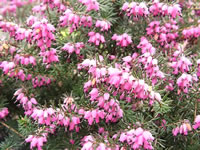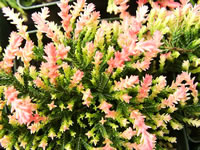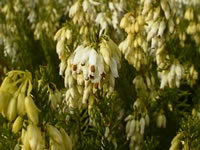How to Grow and Care for Heather Plants
Calluna vulgaris
       
Heather is a compact, shrubby, evergreen ground cover plant from Northern Europe
that covers itself with spires of tiny, brightly colored bell-shaped flowers from late summer through fall.
Heathers are mound forming plants that, depending on the cultivar, may grow anywhere from 4" to 3 feet tall.
The tiny, brightly colored, bell shaped flowers appear on spikes that stand about 5"-10" above the foliage.
There is only one species in the Calluna genus, Calluna vulgaris, but there are hundreds of cultivars that bloom at
varying times and can be easily grown as ground covers, in rock gardens and rockeries or in planters.
With careful planning, you can have Heather plants blooming from June until November.
|
 |
Planting and Growing Requirements for Heather Plants
Heather plants are hardy in USDA zones 4-9.
Heathers can be planted at any time of the year that the soil is workable,
in an area that receives a minimum of 4-6 hours of full sun each day,
except in hot summer regions where they will grow well in light shade.
Insufficient sunlight will result in weak and spindly growth.
Prior to planting, you should mix a generous amount of peat moss, compost
or other organic material (no manure) into your well-drained, sandy or gritty soil.
Heathers are acid soil plants. Test and adjust the soil acidity to maintain a pH of 4.5-6.0.
Plant your Heather so the root-ball is at the same soil level that it has been growing.
Provide protection from cold winter winds.
Water regularly to keep the soil evenly moist, but never soggy.
Soggy soil can lead to root and stem rot or fungal diseases.
|
|
Maintaining Heather in the Garden
Heather plants require little or no fertilizing but if the foliage becomes pale or if flowering wanes,
you can feed them in late winter or late spring, using an acid type or Rhododendron fertilizer.
Apply the fertilizer around the drip line. Always water thoroughly after fertilizing any garden plant.
Heathers should be pruned by shearing back spent flower spikes immediately after they have finished blooming,
except for late fall and winter blooming types, which should be pruned in early spring.
Heather are shallow rooted plants, so always use care when cultivating and weeding around them!
Propagating Heather Plants and Growing them from Seed
Heather plants can be propagated with stem tip cuttings
taken early in the summer.
Heathers self-layer and root readily wherever their stems are in contact with the soil. Rooted segments can be severed and transplanted easily.
Fresh Heather seeds can be sown as they are, but if the seeds have been dried and stored they should be placed in a moist growing medium and kept in the refrigerator for 4 weeks before planting.
Sow Heather seeds directly into the garden in late fall or early in the spring.
Seeds sown indoors will germinate in about a month, if they are kept at a temperature of 65°-70°. |
|
Scotch Heather
Calluna vulgaris
 |
 |
 |
|
|
|
|
Search The Garden Helper:



